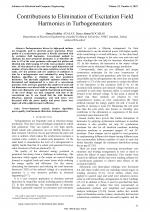| 4/2022 - 4 |
Contributions to Elimination of Excitation Field Harmonics in TurbogeneratorsATALAY, A. K. |
| Extra paper information in |
| Click to see author's profile in |
| Download PDF |
Author keywords
harmonic analysis, iterative algorithms, power quality, total harmonic distortion, turbogenerators
References keywords
machines(10), kocabas(7), design(7), novel(6), harmonic(6), analysis(6), winding(5), synchronous(5), rotor(5), reduction(5)
Blue keywords are present in both the references section and the paper title.
About this article
Date of Publication: 2022-11-30
Volume 22, Issue 4, Year 2022, On page(s): 31 - 38
ISSN: 1582-7445, e-ISSN: 1844-7600
Digital Object Identifier: 10.4316/AECE.2022.04004
Web of Science Accession Number: 000920289700004
SCOPUS ID: 85150250164
Abstract
Turbogenerators driven by high-speed turbines are frequently used in electrical power generation. Power quality of a synchronous generator is directly associated with its excitation field harmonics. Conventional method to eliminate the most prominent harmonics is to distribute the slots to 2/3 of the rotor perimeter with equal slot pitches and identical slots while keeping 1/3 of the rotor perimeter without slots. All slots placed on the rotor have equal dimensions and numbers of turns that carry the same excitation current. In this study, new slot positions and new numbers of conductors in slots for a turbogenerator were calculated by using Newton-Raphson algorithm to eliminate the most prominent harmonics. The physically applicable optimum solution was determined and implemented to a rotor of a conventional generator. Only necessary quantities like numbers of turns and slot dimensions were altered while no changes to the stator and other rotor dimensions were applied. Operational performance of the novel design was then compared with that of the conventional one. It was traced that the total harmonic distortion, material consumption, and total losses were decreased while the power quality and power factor were improved with a slight increase in efficiency. |
| References | | | Cited By |
Web of Science® Times Cited: 1 [View]
View record in Web of Science® [View]
View Related Records® [View]
Updated 3 weeks, 5 days ago
SCOPUS® Times Cited: 1
View record in SCOPUS® [Free preview]
View citations in SCOPUS® [Free preview]
[1] A Novel Asymmetric Hybrid-Layer Del-Shaped Rotor Interior Permanent Magnet Motor for Electric Vehicles, Suphama, Mathus, Seangwong, Pattasad, Fernando, Nuwantha, Jongudomkarn, Jonggrist, Siritaratiwat, Apirat, Khunkitti, Pirat, IEEE Access, ISSN 2169-3536, Issue , 2024.
Digital Object Identifier: 10.1109/ACCESS.2023.3347777 [CrossRef]
Disclaimer: All information displayed above was retrieved by using remote connections to respective databases. For the best user experience, we update all data by using background processes, and use caches in order to reduce the load on the servers we retrieve the information from. As we have no control on the availability of the database servers and sometimes the Internet connectivity may be affected, we do not guarantee the information is correct or complete. For the most accurate data, please always consult the database sites directly. Some external links require authentication or an institutional subscription.
Web of Science® is a registered trademark of Clarivate Analytics, Scopus® is a registered trademark of Elsevier B.V., other product names, company names, brand names, trademarks and logos are the property of their respective owners.
Faculty of Electrical Engineering and Computer Science
Stefan cel Mare University of Suceava, Romania
All rights reserved: Advances in Electrical and Computer Engineering is a registered trademark of the Stefan cel Mare University of Suceava. No part of this publication may be reproduced, stored in a retrieval system, photocopied, recorded or archived, without the written permission from the Editor. When authors submit their papers for publication, they agree that the copyright for their article be transferred to the Faculty of Electrical Engineering and Computer Science, Stefan cel Mare University of Suceava, Romania, if and only if the articles are accepted for publication. The copyright covers the exclusive rights to reproduce and distribute the article, including reprints and translations.
Permission for other use: The copyright owner's consent does not extend to copying for general distribution, for promotion, for creating new works, or for resale. Specific written permission must be obtained from the Editor for such copying. Direct linking to files hosted on this website is strictly prohibited.
Disclaimer: Whilst every effort is made by the publishers and editorial board to see that no inaccurate or misleading data, opinions or statements appear in this journal, they wish to make it clear that all information and opinions formulated in the articles, as well as linguistic accuracy, are the sole responsibility of the author.



